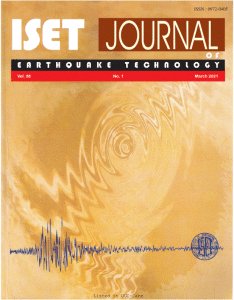Home > Issues & Journals
SEISMIC INPUT MOTIONS FOR NONLINEAR STRUCTURAL ANALYSIS
Bruce A. Bolt
Paper No.: 448
|
Vol.: 41
|
No.: 2-4
|
December, 2004
|
pp. 223-232

Abstract
A major challenge in the characterization of the seismic demand for large critical structures has occurred in the last decade. The ground motion parameterization and estimation procedure now reflect more realistically the seismological properties of the fault source, three-dimensional wave path, and wave generation. In the usual design analysis, input motions for the selected safety evaluation earthquake are scaled to peak ground acceleration. For the linear response of important structure, both amplitude response spectra and standard accelerograms (“time histories”) are used as supplements. With stimulus from seismological studies of recent earthquakes, this approach is now significantly modified. Assessment of the onset and evolution of nonlinear structural deformations in large bridges, dams, and other critical structures requires also consideration of the complementary velocity and displacement input seismic motions, including their phase response spectra, directivity pulses, and fling. Attenuation relations, largely limited in the past to peak ground acceleration, have become dependent on frequency and source mechanism; and work is progressing on the estimation of the (seismically defined) duration and the phase characteristics of ground velocity and displacement. Earthquake-resistant design of multisupported large structures requires consideration of the incoherency of horizontal-component wave motion and the time variation of strain at long periods. Also vertical seismic motions that satisfy wave theoretic compatibility and coherency constraints are needed.
Recent damaging earthquakes, including the 1989 Loma Prieta, 1994 Northridge, and 1992 Landers, California, the 1995 Kobe, Japan, and the 1999 Chi-Chi, Taiwan, earthquakes have provided many freefield accelerograms over a wide range of distances. The resulting spatio-temporal correlations allow for the joint application of seismological and engineering expertise. The seismic response of numerous structures predicted from design procedures can now be compared with the actual seismic demand. The history of cracking, crushing by rocking, and other nonlinear degradations of large structures will in the future be able to be followed in the records of digital accelerometer and displacement devices on the shaken structure: analysis will need forensic skills in engineering seismology.
These changes mandate a close integration of strong-motion seismology and structural and geotechnical engineering if the full value of structural response recordings on structures in future earthquakes is to be gained and transferred into codes and improved nonlinear dynamic analysis procedures. In particular, near-fault directivity fling-pulse contributions in velocity time histories and response spectra are now accepted as critical for engineering design in relevant hazard zones. Examples will be discussed for large bridges in the San Francisco Bay region.
Keywords: Coherency, Fling, Ground Motion, Nonlinear Response, Plate Tectonics
©2025. ISET. All Rights Reserved.